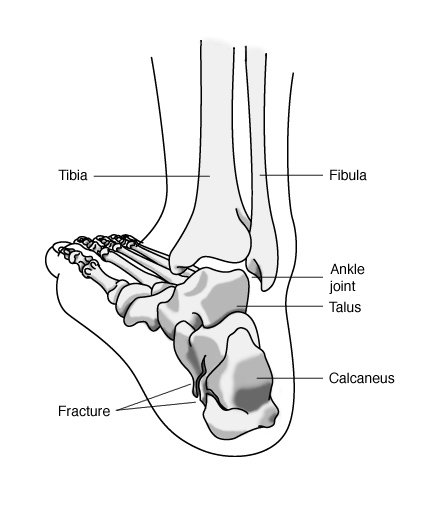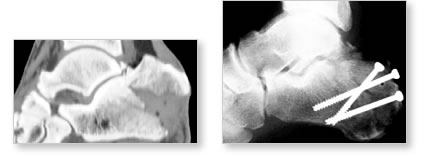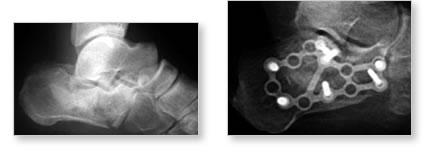
Heel Fractures
Synopsis
Itís not easy to break your heel bone (calcaneus). Because it takes a lot of force, such as that sustained in a motor vehicle accident or a fall from a height, you may also incur other injuries as well, particularly to the back.

Signs and symptoms
Pain
An inability to bear weight
The pain may be centered on the outer side of the ankle, just below the lower leg bone (fibula). Or, it may be focused in the heel pad, particularly when you try to put weight on the foot. Your foot may become swollen and stiff. See your doctor right away, because if the bone heals improperly, severe problems may result later.
Diagnosing a heel fracture
Your doctor will try to pinpoint the area of pain and tenderness. You will probably need to get several x-rays of the heel and ankle area. A computed tomography (CT) scan may also be helpful. If you are also experiencing back pain, your doctor will recommend x-rays of the lower back as well to see if there is a fracture there.
The nerves that bring sensation and movement to the foot pass close to the heel bone. Your doctor will check their functioning to ensure that there is no damage. He or she will also make sure that an adequate supply blood is flowing to the toes and that pressure is not building in the muscles of the foot (compartment syndrome).
 |
||
|
||
Treating heel fractures
If the pieces of broken bone have not been pushed out of place by the force of the injury, you may not need surgery:
Your foot will need to be elevated above the level of your heart and wrapped in a bulky, compressive dressing to keep the bones from shifting.
Ice packs, applied for 20 minutes every hour or two, can help reduce swelling and pain.
Your doctor may apply a splint until the swelling goes down, which can take one to three weeks. Then the doctor may give you a removable splint and prescribe some exercises to maintain flexibility and movement.
You wonít be able to put any weight on your foot until the bone is completely healed, which takes at least six to eight weeks, and perhaps longer.
Surgical treatment
If the bones have shifted out of place (a displaced fracture), you will most likely need surgery. A metal plate and small screws are used to hold the bones in place. A bone graft may be used to aid in the healing of the fractures. The incision will be bandaged and a splint applied until it is healed. Then, youíll get a removable splint so that you can begin exercising the joint. You wonít be able to put any weight on your foot for approximately 10 weeks after surgery. When you begin walking, you may need to use a cane and wear a special boot. It may take up to a year for the injury to heal completely. Depending on the type of job you have, you may not be able to return to the same type of work. Because of the amount of force needed to break the heel bone initially, even if your fracture heals properly, your foot may never be the same as it was before the injury. You may continue to experience stiffness and you may need to wear a heel pad, lift, or cup as well as special shoes with extra depth in the toe compartment.
 |
|
| This fracture of the calcaneus above has been fixed with screws that have been inserted through skin punctures instead of large skin incisions. |
 |
| The x-ray on the left shows the foot prior to surgery. The x-ray on the right shows the foot after the procedure. Note that the height and shape of the calcaneus have been perfectly restored. |